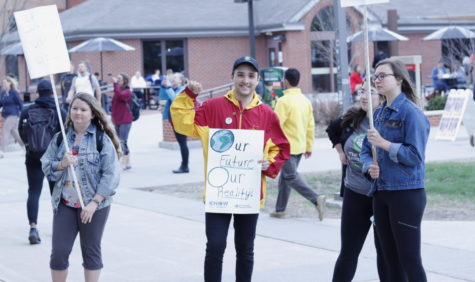Iowa State to build 4.6-acre compost facility
February 22, 2008
The Council on Sustainability met Thursday in 160 Heady Hall to discuss sustainability in Ames and on the ISU campus.
Ames city employees focused on issues pertaining to emission levels in the city of Ames, and representatives from the campuswide anti-litter campaign spoke separately about the Keep Iowa State Beautiful campaign. The Solar Decathlon Club was also among the groups that spoke Thursday night.
Susan Gwiasda, public relations officer for the city of Ames, and Paul Hinderaker, director of fleet services, began the meeting by promoting several environmental initiatives for the city under the “Ecosmart” name. Gwiasda said the Ecosmart title represents many of the city’s initiatives that have been in place for several years, as well as newer initiatives.
“Our [environmental] efforts began about a year ago,” Gwiasda said.
She said that after some Ames citizens asked city officials what Ames was doing in the environmental sector, they committed to make Ames an environmentally sustainable community.
Hinderaker presented newly collected data on emissions levels for the city’s facilities and fleet from 2001 to 2006. The same data will also be presented to the City Council on Tuesday as part of the Cool Cities Act. The City Council officially joined the Cool Cities Act last summer, Hinderaker said.
The Cool Cities Act, together with the related U.S. Mayors Climate Protection Agreement, was signed by Mayor Ann Campbell last May. Compiling an inventory of carbon emissions was the first part of a five-step plan outlined by the Cool Cities Act, Hinderaker said.
The other goals, stated in order, are to set specific reduction goals and benchmark dates, to develop strategies to reach those goals, to implement those strategies and, finally, to monitor the progress made.
One important piece of the emissions data Hinderaker presented was the average yearly rate of 13,352 tons of greenhouse gas emissions generated by the city’s fleet and city facilities (excluding electric plants) in Ames from 2001 to 2006.
An important part of the “Ecosmart” program is the Resource Recovery Plant, which converts a large portion of the city’s garbage into energy. Gwiasda promoted it as an environmental initiative the city of Ames already has in place. She emphasized that Ames is asking citizens to recycle glass instead of throwing it in the trash and to conserve water.
Jennifer Garrett, program coordinator for the Memorial Union, spoke about the Keep Iowa State Beautiful campaign, an anti-litter organization affiliated with the larger Keep Iowa Beautiful organization.
“Our grounds crew doesn’t have the time to pick up all of the litter on campus,” Garrett said.
Keep Iowa State Beautiful is a committee made up of students, faculty and staff that makes efforts to take away from the mass of litter that collects on campus.
Garrett mentioned that Keep Iowa State Beautiful would coordinate with freshman orientation programs and Destination Iowa State to promote a litter-free campus early on in students’ academic careers.
She also said the committee works with student groups to ensure adequate numbers of trash cans are in place for student events to help eliminate litter.
Scott Williams, graduate student in materials science and engineering, spoke about Solar Decathlon, an international contest Iowa State is participating in to build a sustainable, 800-square-foot house to be presented in Washington, D.C.
“We are engaged in a multidisciplinary proposal to present high-end solar energy design and technology from Iowa in an international contest,” Williams said.
He said the group consisted of faculty members, graduate and undergraduate students. They were to be judged on such areas as architecture, market viability, engineering, lighting design, communications, comfort zone and appliances.
















